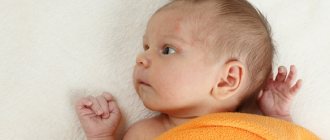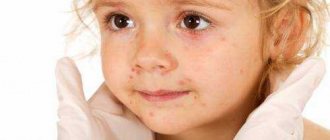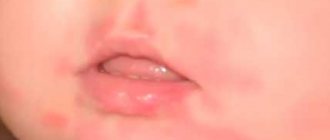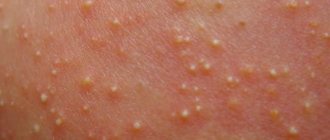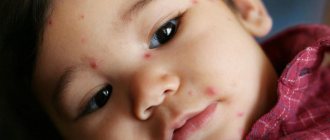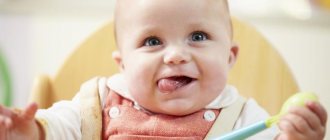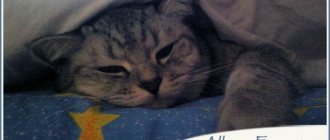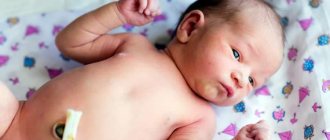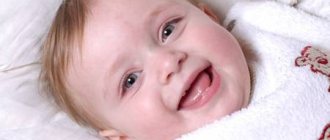Often, unpleasant symptoms in the form of rashes on the baby’s body throw not only young but also experienced parents into panic, and most of them immediately begin treatment without resorting to the help of doctors. You should not rush into such actions, because some alarming signs may indicate dangerous processes in a small organism. In order to correctly determine how dangerous a rash on a baby’s neck can be, a photo with explanations will certainly help you understand some of the features of these manifestations.
Newborn acne, what it looks like and is it dangerous?
Many parents are well aware of what newborn acne is, and they know very well that this manifestation is not dangerous for a small organism. The only thing that should not be forgotten is that there is no danger of a rash only if adults managed to correctly recognize this symptom. It will help to identify with a high probability a rash on the neck of a baby with a photo with explanations that describe in detail these alarming signs in babies.
Even scientists cannot figure out the causes of acne in children, so it is generally accepted that these symptoms are associated with hormonal imbalance in the body.
Under the influence of hormones, the sebaceous glands increase their activity, which leads to excessive sebum production.
Irritation and clogging of pores leads to the appearance of rashes.
In the photo you can see what these rashes look like. There is no need to worry too much about them; after a few months they usually disappear completely without additional measures.
If this does not happen, be sure to consult a doctor who will determine the reason for such a long disappearance of acne.
Miliaria - what does this type of rash look like in a baby?
A photo with explanations often helps parents identify a rash on their baby’s neck, because it is much more useful and easier to visually view pimples than to study information on this topic, which is quite difficult to understand. Another symptom that can be observed in a baby is heat rash.
The culprits of this manifestation are usually parents who do not adhere to medical recommendations and take too careful care of their beloved child.
There are many reasons for the formation of prickly heat:
- rare bathing of the baby;
- clothes that are too warm;
- excessive wrapping;
- heat in the room.
Thanks to warm clothes (especially scarves or sweaters with a long neck), the neck is constantly wet, and such perspiration certainly leads to the appearance of prickly heat.
The photo clearly shows what exactly this type of rash looks like, which is also not considered too dangerous, but if parents do not take immediate measures to eliminate the cause of its formation, it threatens to develop into more unpleasant manifestations.
Hormonal neonatal acne - what is it?
Many parents, who are forced to see a doctor by rashes on their baby’s neck, panic when diagnosed with hormonal neonatal acne. What is it and what does it look like? In the photo you can see this manifestation, which causes a lot of anxiety in adults.
Doctors usually assure that there is nothing special about this type of rash, and it goes away quickly and without much discomfort for the child. It is quite difficult to notice these tiny pimples - they are almost invisible. Doctors believe that their appearance in babies is due to hormonal changes that occur in the mother’s body during pregnancy. These manifestations lead to the fact that the small body, under the influence of hormones, reacts negatively to this influence of the mother’s body.
You should not worry about such manifestations - they disappear quite quickly. You should seek medical help only if the pimples begin to fester over time and cause discomfort to the child.
What does diathesis look like and what is it?
Diathesis is the most common type of rash that most often appears in infants. What does this unpleasant phenomenon look like? The photo clearly shows that these are scatterings of small pimples, which can sometimes be accompanied by peeling or itchy scales. Such symptoms cause a lot of trouble for the baby, because along with the rash comes discomfort and severe itching.
There are many reasons for the appearance of such an unpleasant symptom, and most often the mother’s poor diet leads to the formation of rashes. Scientists have found that a child can suffer from diathesis even in the mother’s stomach, and this can lead to considerable complications later.
The mother’s consumption of allergens is not necessarily the only reason for the appearance of the rash; there are also many provoking factors for the formation of these unpleasant signs on the baby’s delicate skin. Among them:
- change of residence, usually a move to an unfavorable climate;
- the composition of the microflora in the intestines is disturbed;
- carried out preventive vaccination;
- the child’s reaction to various allergens that may be in the room (pollen from indoor plants, pet hair, indoor dust);
- flowering of some shrubs or trees.
You should not try to find out on your own what exactly the child’s body reacts to with a profuse rash and peeling. You should definitely consult a doctor, who will determine what caused the irritating formations on the baby’s skin.
Diaper rash - what is it, causes of formation
You should not treat diaper rash, which often occurs in your baby, on your own. What does this type of rash look like? In the photo you can see that these are extensive red spots on the delicate skin of the baby, accompanied by abundant scatterings of pimples. If you touch these places, you may feel that they are hot and slightly swollen.
What factors can cause such formations that bring a lot of discomfort to the baby? There are quite a lot of them:
- lack of air (parents wrap the child too carefully);
- incorrectly selected food products;
- moisture;
- household chemicals (often washing powder, which can cause a rash);
- heat.
As well as, you should not experiment and independently determine why your baby has rashes. It is better not to delay a visit to the doctor, who will find out what factors need to be eliminated in order to get rid of unpleasant discomfort.
Allergy - what it looks like, what it is, causes
How does an allergy signal itself? These are usually bright red spots that appear on the baby's neck. The photo will help to accurately identify this type of rash, which often occurs in infants. The diameter of these formations can vary - from tiny spots to solid areas that almost completely cover the baby’s neck.
Checking whether it is an allergy is quite simple, and parents can independently verify their suspicions. Just press lightly with your finger on the red spot and it should disappear for a while. If it does not disappear, it means that this is a completely different type of rash, which can be quite dangerous for the child.
Doctors are confident that a child will have allergies for life, so you need to find out the allergen immediately - this will help protect your beloved child in the future. If you cannot do this without the help of a doctor, be sure to consult an allergist who will help determine the cause of the allergic manifestation. Perhaps it's food:
The doctor will also advise which medications it is advisable to keep on hand if it was not possible to protect the baby from the allergen in a timely manner.
Urticaria - what factors cause this type of rash, how to determine
Another manifestation that may appear on the delicate skin of children is urticaria. The photo shows in detail that this is a rather serious problem that requires immediate medical intervention, especially if it concerns infants. The disease usually looks quite scary - with light red spots and numerous large blisters. The formations cause severe itching, which leads to irritation of the baby, frequent crying, problems with sleep and moodiness. It’s even worse if a child begins to tear this manifestation with his nails - this threatens with wounds and abrasions, which, in turn, can become inflamed and even infected.
After the birth of a child, many mothers are horrified to find white or red pimples on the baby’s body. The whole family is wondering – what to do? But you shouldn’t panic so quickly, because rashes do not always indicate the presence of pathology.
The rash comes in different colors, sizes and is located on different parts of the body, causing discomfort or not affecting the child’s condition in any way. All this depends on the type and mechanism of their appearance.
Hormonal crisis
During pregnancy, the organisms of the mother and fetus are closely connected to each other by the circulatory system. In later stages, the placenta becomes more permeable, and the mother’s hormones penetrate through it and affect the baby’s body.
1-3 weeks after birth, the effect of these hormones ends and small white pimples appear on the baby’s body (milia). They have no signs of inflammation, are absolutely painless and disappear without a trace after 2-3 months.
Such a rash does not require treatment, because it is a physiological phenomenon. Milia are sterile, therefore, when trying to squeeze out, there is a risk of introducing and spreading an infection, that is, only. Will make the situation worse.
Allergy
When a red rash appears, which will be located on the face, arms or stomach, you should first of all think about allergies. Such rashes can itch, which will lead to irritability and tearfulness in the child. He may try to scratch it on his own. The reaction develops mainly to foods eaten by a nursing mother (oranges, chocolate, etc.) or pets (wool, daphnia).
Diathesis
This is a food intolerance to certain foods that goes away over time. It manifests itself as red spots, pimples, peeling and crusts on the baby’s face.
Dermatitis
The baby's skin is very delicate and sensitive. With prolonged exposure to moisture, steam or elevated temperatures (diapers, nappies), maceration develops, against which a painful rash appears. Especially often, we can observe such a picture in skin folds and places where clothing touches.
Dysbacteriosis
At birth, the baby's intestines are sterile. After the first sip of milk, the gastrointestinal tract is activated and colonized by the mother's microorganisms. Until a stable microflora is established in the baby, he may be tormented by dysbacteriosis, intestinal colic and small reddish rashes all over the body.
Types of acne on a newborn's body
Conventionally, depending on the appearance, they can be divided into 2 groups:
- Red pimples on the body of a newborn. This includes all non-purulent processes (diaper rash, infectious diseases, irritation due to dysbacteriosis and diathesis);
- White pimples on a newborn's body require much closer attention. A pustule is a formation filled with pus. The appearance of such a rash indicates the penetration of the pathogen into the body. If such a rash is widespread, then this is a reason to urgently consult a doctor.
When rashes appear in infants, parents should be vigilant. The rash should be carefully examined and, if possible, counted (to periodically control the quantity). Be sure to measure your baby's body temperature. You can also take the following steps:
- Hygienic regime. If there is no fever, the child needs to take a bath. It is advisable to add a decoction of herbs (chamomile, calendula, sage), which are hypoallergenic antiseptics, to the water. This procedure will help disinfect, soften and soothe the skin. It is better not to use chemicals.
- Throughout the day, wipe the damaged areas with a damp towel (2-3 times) and leave in the air until dry.
- The child should be dried with a natural, soft towel. It is advisable that it is not painted in bright colors, because a reaction may develop to chemical dyes. You need to wipe gently - getting wet.
- Air baths. To do this, you need to create a comfortable temperature regime - 25-26 o C and free access of air to the damaged areas.
- After water procedures, you need to thoroughly powder your skin.
- If you are breastfeeding, you need to urgently review your menu. Everything red, spicy, fried, fatty, eggs and chocolate should be excluded. From vegetables and fruits, you can eat what grows within your region.
- If there are animals in the house, they must be isolated. Daphnia (fish food) is also an allergen. You should remove fluff and carpets from your home and carry out wet cleaning regularly. Books must be behind glass.
- Do not use alcohol solutions to wipe the rash. Babies' skin is very delicate and sensitive - chemical burns can occur.
- For wiping, you can use Chlorophyllipt solution and infusions of various plants (chamomile and sage are popular).
- Lubricate the skin with cream or lotion. This will hydrate it and help it recover.
If there is no improvement, you urgently need to consult a qualified doctor.
Acne in a child during the first years of life
Acne in a child of the first year of life can also be one of the types of acne - childhood acne (acne infantum). Most often, they are associated with an excess of testosterone in the blood plasma caused by metabolic disorders. With this disease, acne on a child’s face often becomes inflamed, which is why they sometimes leave scars.
Most often, childhood acne affects boys, appearing between the ages of three months and a year or two and sometimes persists up to three or four years.
To summarize, we can say that the appearance of any type of acne in a child should be a reason to consult a doctor and find out the exact cause of its appearance.
In the first days of a baby's life, a newborn's skin may suddenly become covered with small pimples. These pimples can have different appearances - they can be red, white, they can cover certain areas of the skin, they can appear on the face, or on the whole body. In order not to puzzle over why pimples appeared on the face of a newborn, you need to know about the most common causes of their appearance, and, depending on the cause, select treatment. In general, there are acne that require treatment, and there are those that go away on their own.
Prevention of pimples on a newborn's body
To prevent the appearance of rashes, you need to pay a lot of attention to hygiene - the baby should have his own bath, towel and individual detergents.
Complementary foods should be introduced gradually and allergenic foods should be avoided. Diapers should be changed frequently - the child should not be allowed to remain in wet diapers for a long time. The temperature and humidity of the room where the baby is located should be comfortable.
In the first months of life, young mothers can observe how pimples suddenly appear on the baby’s delicate velvety skin. Usually, inexperienced mothers begin to worry: consult a doctor, read specialized literature, consult with grandmothers. Sometimes these worries are justified, but in most cases, pimples in newborns are a common occurrence, observed in 85% of children.
There are many reasons why pimples appear in infancy. Some rashes occur as a result of natural hormonal processes, others - as a concomitant symptom of various diseases. Based on the nature of the pimples, the doctor determines the need for treatment.
About prevention
In order to encounter such an unpleasant phenomenon as acne as rarely as possible, timely prevention is necessary:
- if a mother is breastfeeding, you need to be especially attentive to the foods she eats;
- in the case of artificial feeding, give preference to hypoallergenic formulas;
- allow the child to take air baths when changing a diaper;
- monitor the temperature and humidity in the children's room, give access to fresh air;
- use hypoallergenic baby laundry detergent;
- bathe your baby daily.
Summarize. If your baby develops small white pimples within a month or immediately after birth, do not sound the alarm. They are not dangerous and will soon disappear. Even red rashes can, in most cases, be prevented. But if the acne does not go away for a long time, spreads further throughout the body, or the child has a high fever, then you should definitely see a doctor.
Hormonal pimples in newborns
This type of pimples is medically called acne of newborns, or neonatal cephalic pustulosis. Immediately after birth, many babies may develop pimples caused by a hormonal crisis. The fact is that in the last months of pregnancy, the mother’s hormones, produced by the pituitary gland, placenta and ovaries, pass into the fetus’s body. Too much of these hormones causes the appearance of pimples on the face of newborns. That is why the baby’s skin condition resembles the face of a teenager during puberty.
Neonatal acne is a non-contagious disease that does not require drug treatment and usually resolves by the third month of life.
In cases where the child has increased production of androgens, the pimples may have white or black heads. Hormonal pimples usually appear in newborns on the head, cheeks, nose and chin.
Acne in a child in the first months of life
Of great concern to parents is the appearance of acne in a small child (infancy).
Acne in newborns
At the same time, acne can appear on the face or cover the entire body. This is how a skin disease called “newborn acne” (acne neonatorum) manifests itself.
Why does acne appear in children?
It usually appears within six months from the birth of the baby, and about 20% of newborn children suffer from it.
Sometimes even pediatricians confuse newborn acne with atopic (allergic) dermatitis or other types of rash, so it is important for parents to know the distinctive signs of this disease.
Causes of acne
There are several of them:
The appearance of yellowish, whitish-pearly or white pimples in a child, looking like papules or pustules. No comedones. Pimples are located in close groups, sometimes merging into large spots. Frequent areas of rash: all areas of the face, back of the head, penis (in boys). Much less commonly, the rash appears on the neck and upper chest.
White pimples in newborns
Whiteheads, or closed comedones, usually appear on the cheeks, chin and forehead of an infant. They occur in almost 50% of children. Closed comedones are dense, white or yellow nodules (papules) that rise above the skin. Pimples in a newborn can appear either singly or localized in a group in separate areas of the face. In addition to papular rashes, newborns may experience purulent pustular elements. They, like papules, go away without medication and do not leave marks on the skin.
In the first two weeks of life, white pimples called milia may appear in a newborn. They are very small, without inflammation and resemble fat sacs. The rash goes away without outside intervention after the formation of the glands and ducts of external secretion is completed.
Why do they appear?
As we noted above, most often white pimples appear on the nose, forehead and chin. That is, in the very places where the sebaceous glands work more actively, and this is not without reason.
White spots appear in most newborns. As a rule, the mother first discovers them between the first and fifth days of the child’s life. These white pimples are also called milia.
The main reason for the appearance of milia is an imperfect system of sweat and sebaceous glands in infants.
Judge for yourself, the baby finds itself in a new world, with different temperature conditions and an unusual environment. He needs time to adapt his body to new conditions.
Unlike mommy's belly, in the big world the ambient temperature and humidity are not stable, and the body has to adapt by working in new ways.
Various kinds of rashes with a white head on a child’s cheeks, if they are not inflamed, can also be one of the manifestations of imperfect functioning of the sebaceous glands. You should not try to squeeze them out or otherwise influence them mechanically - the baby may become frightened by the painful sensations and cry, and you may injure the delicate skin and cause an infection.
If rashes appear suddenly and in large numbers, and if they cause concern for you and your child, it would be best to consult a doctor.
Red pimples in newborns
These rashes can have a different nature and often require close attention from both the mother and the pediatrician.
Red pimples in a newborn can be caused by:
- Heat rash;
- Allergies;
- Dysbacteriosis;
- Infectious diseases.
Heat rash in newborns is a fairly common phenomenon that almost all parents encounter sooner or later. It appears from overheating and can occur in both hot and cold weather. Many small red pimples are already located on irritated, reddish areas of the skin. If the child is not properly cared for, pustules may form on the inflamed area. Miliaria does not require special treatment. Nevertheless, the mother must follow a number of rules: bathe the baby daily, ventilate the room, use drying powders, and dress according to the weather.
Allergic pimples in newborns are caused by the body's reaction to various antigens. They can have different origins - food, medicine, plant pollen, and much, much more. Food allergies are the most common. In this case, the mother needs to reconsider her diet or change the milk formula if the child is bottle-fed. Allergic rashes of any nature go away provided that the causative agent of the allergy is eliminated in a timely manner.
Violation of the intestinal microflora can cause dysbiosis, which is accompanied by small rashes throughout the body. In this case, you should immediately consult a doctor in order to cure dysbiosis. Pimples will go away on their own after the intestinal microflora is restored.
The cause of pimples in newborns can be infectious diseases, which are always accompanied by high fever.
Rashes appear with diseases such as:
- Roseola;
- Rubella;
- Chicken pox;
- Scarlet fever;
- Measles;
- Enterovirus infection.
In this case, treatment should only be prescribed by a doctor, and it should be aimed at fighting the infection, and not at eliminating its symptoms. Pimples, as in the case of bacteriosis, will disappear as you recover.
Pimples as a manifestation of various diseases
When should you sound the alarm? Red pimples with skin inflammation can be a signal that an infection has appeared in the baby’s body. A characteristic sign confirming fears will certainly be an elevated temperature. What diseases are likely when rashes appear:
- roseola;
- rubella;
- chicken pox;
- scarlet fever;
- measles;
- enterovirus infection.
If you are already observing obvious signs, the only action on your part is permissible - calling a doctor. No self-prescription of medications! Treatment is only within the competence of a specialist - pimples will go away with proper treatment.
What to do if your newborn baby has pimples
First of all, do not panic, but try to find out the reason. For this purpose, carefully examine the pimples, their location, color, and measure the child’s temperature. If the baby’s body temperature is normal, then you can often do without the help of a pediatrician. However, you should not act as a doctor by using ointments, powders and medications yourself. To dry out rashes, it is not recommended to use brilliant green, iodine, potassium permanganate and alcohol. To treat pimples in newborns on the head, face and body, it is better to use medicinal decoctions of string and chamomile. It is also necessary to follow hygiene rules, review your diet or change children's cosmetics and hygiene products. If the rash does not go away or is accompanied by a high temperature, it is recommended to consult a doctor who will diagnose the disease and prescribe the necessary treatment.
If a rash is detected in a baby, this fact cannot be ignored. Calmly find out the origin of the rash and relieve the baby from this discomfort.
Acne of infectious origin
A rash of this kind always accompanies a certain infection, being one of the symptoms of the disease. It manifests itself in childhood roseola, measles, scarlet fever, rubella, and chickenpox. Typically, such diseases develop rapidly, accompanied by high fever, and are treated only under the supervision of a pediatrician.
Vesiculopustulosis
Staphylococcus and streptococcus can cause vesiculopustulosis in newborns. Often the disease occurs against the background of untreated prickly heat. First, blisters with clear liquid form on the body, then they turn red, and on the 2nd day pus appears in them.
Staphylococcus more often than other pathogens leads to vesiculopustulosis
A baby with such an infection is not bathed, but instead the skin is treated with a solution of furacillin or a very weak solution of potassium permanganate. Afterwards, you can dry the pustules with brilliant green or methylene blue, and use antibiotic ointments. Sometimes, in severe cases of the disease, the doctor may prescribe antibacterial drugs for internal use. The course of treatment is from 7 to 10 days.
Causes of pimples in babies
The cause of the rash can be not only external irritants, but also the growing up and development of the child. If the baby is about two to three weeks old, and pimples appear in the cheeks and neck, this indicates the beginning of the formation of hormonal levels. As a rule, the rash goes away on its own by the age of three. The peculiarity is that the pimples have a constant red color, sometimes with a whitish center.
Pay attention to nutrition. If, after eating certain foods, the redness in the cheek area becomes noticeably brighter, this indicates the presence of an allergy. Eliminate an inappropriate product from the diet; usually a small child reacts with a rash to the following irritants: citrus fruits, sweets, and sometimes cow’s milk.
You can avoid acne by following a diet for a nursing mother. Give your newborn air baths several times a day. Wash children's underwear separately from adults, using special detergents.
If the appearance of acne is accompanied by colic, anxiety, and stool disturbances, this may be a signal of intestinal dysbiosis. Take an extended stool test. Discuss your results with your pediatrician. If abnormalities are detected, the child will be prescribed the necessary medications to restore the microflora.
Sometimes acne on the face can indicate the beginning of the development of a disease. Don't diagnose yourself. Contact your local pediatrician for advice.
Climate change can also trigger acne. The baby does not need treatment, since the rash disappears after several days of adaptation and does not require special attention.
A room that is too warm or dressed too warmly can also cause rashes - prickly heat develops. Typically, pimples begin to appear on the baby's neck and then move up to the face. You can tell that a child is too hot by the fact that his face turns red. Don't overheat your baby. When dressing your baby, use a simple scheme: “clothes for yourself + 1”. This means that a child needs one more thing than an adult. For example, you are wearing a T-shirt, the baby is wearing a T-shirt and a sweater.
Causes of acne on the faces of infants
It is considered completely normal for pimples to appear on the face of an infant during the first few months of his life. The reason for this phenomenon is a hormonal imbalance in the child, caused by a significant release of maternal hormones into the blood - estrogens, which also enter the blood of the newborn child. Often, pimples are quite small, invisible under the skin and can only be detected by touch. However, the appearance of a rash in a baby can also be caused by non-hormonal reasons.
Rashes that look like white pimples often appear on the face of an infant. The white contents are located in their central part, and the rash is not inflammatory in nature. They are localized on the forehead, chin, and wings of the nose. The reason for the appearance of such rashes is the immaturity of the sebaceous glands of the infant. As a rule, they disappear on their own within 2-3 months.
Walking outdoors in the cold season can result in small red pimples. Their appearance indicates the beginning of adaptation of the skin to changing environmental conditions.
Red pimples that appear on the face of a baby, also related to temperature changes, are called prickly heat. Its appearance occurs in the folds of the skin due to overheating, poor care of the baby and excessive humidity.
If you take poor care of your baby, pimples may appear on the baby's head. They are covered with dry yellowish crusts and are called “gneiss”.
The cause of allergic rashes on a child’s face can be poor nutrition of a nursing mother. In appearance, they resemble a nettle burn and are accompanied by itchy skin. Their appearance can be caused by the use of chemicals such as washing powders, as well as baby care products.
Diseases with pimples on the face in infants
During the first year of a child’s life, infectious diseases may occur, accompanied by the appearance of pimples on his face. Similar diseases include scarlet fever, one of the symptoms of which is bright red pimples that appear on the folded surfaces, less often on the face, with the exception of the triangle in the area of the lips and nose. This is accompanied by an increase in body temperature, peeling of the skin on the feet and palms, redness of the mucous membrane of the throat and the acquisition of a crimson tint of the tongue.
Another disease accompanied by rashes is measles. This disease is characterized by the appearance of pimples over several days on various areas of the body.
on the first day on the neck and face; on the second day on the shoulders and torso; on the third day on the legs and arms.
At first, the pimples are red, then they begin to peel off and darken, all this happens against the background of an increase in body temperature and catarrhal symptoms of inflammation of the upper respiratory tract.
The appearance of pimples on the face is also characteristic of chickenpox; they even spread to the scalp. First, a red pimple is detected, sometimes containing a clear liquid inside, which is replaced by pus and crusts. Pimples can appear in multiple quantities, periodically their number can increase, all this happens against the background of an increase in body temperature, which is possible if the child gets wet or pulls off some of the pimples. In addition to the rise in temperature, inflammatory symptoms of the respiratory tract and stomach may appear.
Acne rashes on the face of a baby can occur with meningitis. This symptom is quite alarming; at first it looks like small red pimples - hemorrhagic rashes that appear not only on the face, but throughout the body. An increase in their number is possible on any part of the body; it indicates the presence of a virus in the blood that causes the disease. Accompanied by irritation of the membranes of the brain, elevated temperature and deterioration in the general condition of the baby.
If pimples of any type appear in an infant, you should contact your pediatrician and do not self-medicate.
Measures to treat rashes
Having found out the cause of the rashes, begin proper care for them. Wipe your face twice a day with a cotton swab dipped in warm boiled water. When bathing your baby in the bath, add a little potassium permanganate to the water. The water should be pale pink. This will help dry out the resulting pustules. You can use chamomile and string. Do not squeeze under any circumstances, as this may lead to infection in open wounds. Also, to treat redness, do not use fatty oils, antihistamines, hormonal ointments, or powder.
It always becomes a cause for concern for young parents. As a rule, having discovered a rash on their child, mothers panic without reason and blame themselves for not properly caring for the baby. We suggest not rushing into tears, but look at the child more carefully: perhaps the pimple on his face does not pose the danger to his health that your imagination imposed on you? Our experts will be happy to tell you about all types of rashes in children, the causes of their appearance and methods of treating the skin disease. We are confident that after reading our article you will calm down and find a way out of this situation.
To treat or not to treat
In most cases, the small white pimples (hormonal breakouts) go away on their own, so mom just needs to be patient. By about 2 months, most babies can already boast of soft, smooth skin without any acne.
Never squeeze pimples; this can seriously damage the top layers of the skin, cause infection and leave scars.
All doctors advise that if a rash or pimples appear, you need to consult a specialist; only a specialist can make the correct diagnosis.
Can:
If you still want to alleviate the condition of your baby’s skin, the simplest and most proven method is:
- Wash your child with boiled water 2 - 3 times a day;
- bathe the child in a weak solution of potassium permanganate;
- or bathe your baby in a series (bathing in various herbal decoctions). Sequential baths gently care for baby skin. Before daily bathing, add a brewed series to the bath (a large cup per bath) and bathe the child as usual;
- wipe the face and affected areas of the skin with a decoction of string or chamomile;
- It is necessary to ensure proper skin care (link to article below).
It is forbidden:
Red, white, watery, purulent pimples on the face of a newborn
White or slightly reddish pimples that usually appear on the skin of a baby's face are called neonatal acne or neonatal pustulosis. The cause of acne is an excess of the hormone estriol, which accumulates in the placenta during pregnancy and passes to the fetus in the last few months of gestation. Also, white pimples on the baby’s face may indicate a period of adaptation of the baby to environmental conditions. The white rash does not cause discomfort and goes away on its own after a few weeks, when the child’s sebaceous glands are fully formed.
Yellowish-white pimples surrounded by a red ring are called erythema toxicum. They also disappear on their own two weeks after the baby is born. The reason for the appearance of such a rash on a child’s face is the secretion of a large amount of biologically active substances released during the destruction of cells that are involved in allergic reactions. That is, it is a physiological rash that appears on the body in approximately 50% of newborns.
Reddish pimples that affect not only the skin of the face, but the folds of the neck, groin, and area behind the ears are called prickly heat. At the same time, in places of irritation, the skin feels rough to the touch. Sometimes pustules may form. This rash appears because the child sweats a lot.
The high content of hormones in the newborn’s body contributes to the production of large amounts of sebum. It clogs the sebaceous glands, which leads to their inflammation and the formation of small blisters. Experts call such pimples seborrheic dermatitis. Mostly, rashes and crusts appear on the forehead close to the hair, less often on the neck, ears, back, chest, and cheeks.
Watery pimples on the face of children almost always indicate an allergic reaction that manifests itself to clothing or various foods eaten. Often the cause of such a rash is contact with a pet or the use of certain medications. The introduction of new foods into a child’s diet also provokes the development of an allergic skin reaction.
Diaper rash, which occurs in damp places and is subject to friction for a long time, also provokes the appearance of watery pimples. If they are not treated in time, then there is a high probability of a purulent pimple appearing in a child.
Chicken pox also appears on the child's skin as watery rashes. Small pimples with watery contents often occur with herpes.
Purulent pimples on the face most often indicate untimely treatment of prickly heat, allergies, diaper rash, or infection in the child’s body. In such cases, it is impossible to make a diagnosis on your own, so we recommend that you immediately seek help from a doctor.
Other causes of acne in newborns include intestinal dysbiosis, climate and temperature changes, and insect bites. Many babies' skin becomes red and then pimply in the cold.
Red pimples
Prickly heat
The hot season, synthetic clothing or many layers of natural clothing lead to active sweating. As a result, the child's skin becomes moist, and if this condition is repeated day after day, prickly heat occurs. First, a small pink rash appears on the neck, then on the face, and then spreads throughout the body, especially in areas covered by clothing. What to do?
The whole secret is prevention. The air temperature in the room where the infant lives should be up to 22 degrees. If this cannot be achieved naturally, it may be time to consider installing an air conditioner. Dress your baby only in clothes made from natural fabrics and avoid overheating. Then prickly heat, even if it appears, will pass quickly.
Allergic rash
The most common allergic reaction is to foods that a nursing mother has eaten. In this case, small red pimples will make themselves felt within 18 hours after eating, first on the cheeks, then, possibly, on the whole body. To prevent the situation from repeating itself, it is necessary to analyze what you ate that could have caused the allergy. The suspicious product is removed and the baby’s condition is monitored.
If the baby is fed an adapted milk formula, you can try changing the manufacturer and composition of the formula.
There is also contact and inhalation allergies, when a reaction is observed upon contact with pets and synthetic clothing. The rompers may be made of natural cotton, but if they were washed with a non-hypoallergenic baby powder, this can lead to disaster. Allergies can be caused by pollen from indoor plants and even diapers (if the filling in them is of poor quality).
Allergies often look like small red pimples, sometimes crusting over
The solution to the problem is simple: in order for allergic acne to go away, you need to identify the allergen and get rid of it. Sometimes allergy tests are done for this purpose, but this method is suitable for children over 3 years old.
The rash may appear while taking certain medications. For example, vitamins containing iron, antibiotics, and hormonal drugs can provoke allergies. It is not at all necessary that the child accept them. Many drugs pass into breast milk. If you suspect medications are involved in your allergies, stop taking them and consult your doctor.
There is also a type of rash known as urticaria. It is non-allergic in nature and occurs as a reaction of the body to climate changes: cold, heat, direct sunlight. Hives are characterized by red bumps that do not require treatment. They pass as quickly as they appeared.
How to treat acne on the face of newborns, folk remedies
Pediatricians recommend that if acne is detected in infants, go to the clinic to make the correct diagnosis, on which treatment will depend. But there are also general recommendations for eliminating rashes on a baby’s face. The most important thing is to follow the baby’s personal hygiene rules: change the diaper on time, wash the baby’s face with warm water, sterilize nipples and bottles before feeding.
Traditional healers recommend treating pimples on the face of newborns with a decoction of herbs. It could be chamomile, celandine. All of them have antibacterial and drying properties, so they help quickly eliminate acne problems. Preparing the decoction is very simple: brew 1 tbsp. spoon of medicinal raw material with a glass of boiling water, hold in a water bath for 10 minutes, let the product brew. Soak a cotton pad in the warm broth and wipe the baby’s skin with the liquid at least three times a day. If pimples appear not only on the baby’s face, but also on other parts of the body, then a decoction of herbs can be added to the bath when bathing the baby.
But what you shouldn’t do when there is a rash on a child’s face is to squeeze out pimples, wipe them with alcohol-containing wipes and solutions, lubricate the child’s face with fatty creams and use hormonal ointments or antihistamines without a doctor’s prescription.
Do not forget that pimples on the face of newborns are quite common, but it is better to prevent them than to treat them. To do this, the mother must adhere to an anti-allergenic diet, excluding red vegetables and fruits, as well as citrus fruits and sweets from the diet. In addition, be sure to use a special hypoallergenic powder for washing baby clothes. Regularly give your child air baths so that the baby's skin can breathe.
It is imperative to trim your child’s nails so that he does not scratch pimples and cause infection in the wounds. In the baby's bedroom, it is recommended to maintain an optimal air temperature for newborns of 20-22 degrees, with an air humidity level of no more than 70%.
How to treat non-infectious pimples
As we have seen, in some cases there is no need to do anything. Newborn acne and milia go away on their own. It would be good if you show the rash to a doctor to determine the diagnosis and take appropriate measures. But there are some things you can do yourself to alleviate the condition. So…
We recommend reading: Why does prickly heat appear in babies?
Can:
- wash the baby more often (2-3 times a day) with boiled water;
- wipe your face with herbal decoctions (chamomile, string);
- keep the baby’s things clean and iron them;
- change bed linen regularly and iron it;
- promptly carry out wet cleaning in the room where the baby is located, ventilate it;
- bathe the baby in a line.
It is forbidden:
- squeeze pimples (you can spread an infection);
- wipe with alcohol tinctures, fucorcin, brilliant green without a doctor’s prescription (they may not be needed, but they will dry out the skin);
- use fatty creams and ointments (they clog pores and are a good breeding ground for bacteria);
- give antibiotics, absorbents without a doctor's prescription.
Take your baby for walks in the fresh air as often as possible
What to do if pimples don’t go away, nothing helps
As a rule, the rash that forms on the face of babies goes away extremely quickly and painlessly, but, unfortunately, it has the nasty property of jumping from one place to another.
All rashes, of course, subject to the necessary hygiene rules, should disappear within three months. But do not forget that acne on the face of newborns can appear due to infection in the child’s body. Thus, white watery pimples often become harbingers of chickenpox, and a red rash indicates scarlet fever or urticaria. This is not the entire list of diseases dangerous to the health of children that provoke the appearance of a rash.
As a rule, with such pathologies, none of the above methods for treating pimples brings the expected results. Therefore, if the number of acne increases during the day, the child’s temperature rises, and his condition worsens, then you should immediately consult a doctor.
Treatment with traditional methods
Traditional medicine is used to treat acne on the face of newborns. First discuss with your local pediatrician or family doctor the possibility of using herbal infusions. For the procedure of wiping the facial part of newborns, infusions are prepared based on chamomile flowers, marigolds, and string grass.
Infusions of only one herb are used. It is not advisable to use other herbs to treat rashes in newborns.
- Composition with a series: the herbal infusion is harmless, effective in treating pimples from prickly heat, allergies, and skin irritation. To prepare the composition, place a teaspoon of succession herb in a thermos and pour a glass of boiling water. The infusion lasts 2 hours, after which the infusion is carefully filtered. Use a sterile cotton pad or gauze swab soaked in the infusion (temperature 35-36°C) three times a day to wipe the areas of the face with a rash.
- An infusion of chamomile flowers is prepared and used in the same way as in the “Composition with a string” recipe described above. Can be used in the first days after the baby is born. The infusion has anti-inflammatory and antiseptic properties.
- With marigolds: the infusion is made as in the recipes described above. Rubbing a newborn's face with marigold infusion relieves itching, heals wounds, and disinfects the surface of the skin.
